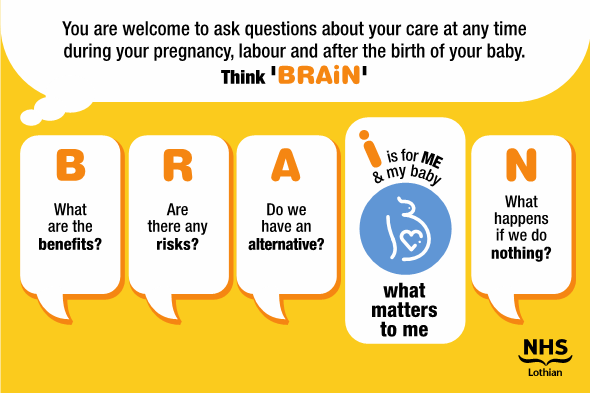Here are suggestions to make your induction a positive experience:
1. Understand WHY you are being offered an induction.
As explained in “Why is an induction being considered for me and my baby?” there are a number of possible reasons and it is important you talk with your midwife or doctor about your personal circumstances and what matters to you. Once you have a good understanding of the reasons and have talked about what is important to you with your midwife or doctor, you will feel more able to make a decision with confidence.
You can also get information from trusted sources that base their advice on research and evidence. You may find these websites helpful:
Inducing labour – NHS (www.nhs.uk)
Overview | Inducing labour | Guidance | NICE
Inducing labour | Tommy’s (tommys.org)
2. Think ‘BRAIN’ to ask questions and discuss options.
Remember that you can think ‘BRAIN’ to ask questions at any point and discuss what the best option would be for you.

Induction is a process with many steps. Not everyone will go through all the steps and you can pause and ask the BRAIN questions at each step to decide what to do next. It is always your choice and you can talk about what other things you can do at each step. For example, have an extra scan or monitoring or wait a little longer to intervene. Going through the BRAIN questions with your midwife or doctor at each step will help you feel in control of your induction.
You can find more information about giving consent and your rights as a patient here:
Informed Consent – Maternity Services (nhslothian.scot)
3. Setting a date… or not.
You do not have to book an induction in advance (unless you feel this will benefit you). You can talk to your midwife or doctor and agree a plan together. You can discuss other options with them that respect what is important to you. You can make decisions as you go and know that you can always change your mind.
If you wish to continue with your pregnancy and wait for labour to start naturally, your midwife and /or doctor will discuss a personal care plan with you. You will be offered the option of some additional monitoring for you and your baby. This might be in the form of appointments for an ultrasound scan to check the placenta and/or monitoring of your baby using a Cardiotocograph (CTG) machine which measures you baby’s heart rate.
If you follow the steps above and decide that induction is the right decision for you and your baby, it may help to:
4. Remember that throughout the induction process you have control and the right to decline/delay a procedure if you feel it isn’t right for you or your baby. You can always ask for more time, not consent to a particular method of induction or halt the process for a while.
5. Take it slowly. You can take your time to decide what to do next and you can ask for time to think about your options at each step. The BRAIN tool is useful to talk about your options and includes the questions about what alternatives there are and whether you can safely do nothing and wait for a while.
6. Build your own oxytocin! Oxytocin is the hormone that your body would naturally produce in labour. In the induction process you may be given a synthetic version of oxytocin via a drip. The more of our own oxytocin we can produce to help this process along, the better! Oxytocin is produced when we feel calm, relaxed and unobserved- so turn out the lights, move the bed out of the middle of the room, turn that space into your safe, birthing nest until your baby is born!
7. Endorphins! In spontaneous labour, as our body produces oxytocin, it also produces a hormone called endorphins. Endorphins are our body’s natural pain relief. There are ways to build up your own supply of endorphins when you are induced: make a ‘home from home’ with your own clothes, blankets, pillows, favourite smells (essential oils for example), your own music and snacks that give energy and that you love. Other useful ways are using a TENS machine and massage or physical touch from your birth partner.
8. Know you CHOICES. If you are having an induction, depending on the circumstances, you may be able to go home with the Cooks balloon or with the pessary in place. In your own home, you will feel more safe, relaxed and unobserved. You may also be able to use the birth centre, and the pool (even on the labour ward). Talk to your midwife or doctor about what is important to you. You may be able to do a lot of the things that you would have liked to do if you had gone into labour naturally.
9. Keep talking to your midwife and doctor.
Try to build a respectful and trusting relationship with them. Ask them what they can to do support your decisions and help you get the things that are most important to you for your birth. Having these discussions early on is much easier than trying to do when you are in the middle of labour. Your birth partner can also play an important part in these discussions and be your advocate later on when you are in labour.
10. Read some positive induction stories so that you can start the process with a positive mindset which in turn is likely to have a positive influence on your labour and birth.













